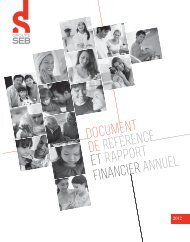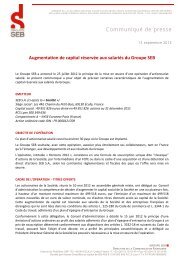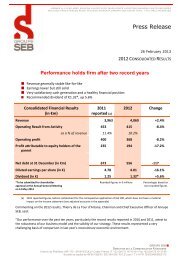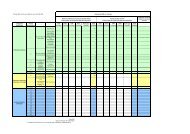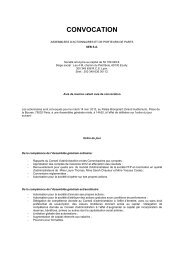Financial Report and Registration Document 2010 - Groupe Seb
Financial Report and Registration Document 2010 - Groupe Seb
Financial Report and Registration Document 2010 - Groupe Seb
Create successful ePaper yourself
Turn your PDF publications into a flip-book with our unique Google optimized e-Paper software.
2 CHAIRMAN’S<br />
CORPORATE GOVERNANCE<br />
REPORT ON INTERNAL CONTROL<br />
The risk analysis <strong>and</strong> internal control processes use two basic tools:<br />
an annual ‘top-down’ review <strong>and</strong> analysis of the main risks. In <strong>2010</strong>,<br />
the members the Group Executive Committee, the Director of Legal Affairs<br />
<strong>and</strong> the Director of IT Systems, the President in charge of Innovation<br />
<strong>and</strong> the President in charge of Strategy were interviewed individually to<br />
help identify <strong>and</strong> analyze the top ten risks that <strong>Groupe</strong> SEB is or could<br />
be exposed to. Estimating a probability, an impact <strong>and</strong> a degree of<br />
preparation for the Group to be ready to manage each of these risks<br />
enables us to establish an annual map of the major risks for <strong>Groupe</strong> SEB;<br />
a ‘bottom-up’ process involving self-assessment questionnaires, based on<br />
processes. These are sent out to each operational entity <strong>and</strong> are designed<br />
to identify possible weak points <strong>and</strong> encourage the practice of internal<br />
control at all levels, with a view to making Group operations more efficient.<br />
In <strong>2010</strong>, the self-assessment process was completed as in previous years,<br />
with one questionnaire every two years for each Group entity.<br />
Added to these two methods of evaluation are regular internal audits of all<br />
entities <strong>and</strong> of all the Group’s functions, as well as the annual <strong>and</strong> half-yearly<br />
reviews carried out by the Statutory auditors.<br />
In <strong>2010</strong>, the self-assessment questionnaires for each process were<br />
thoroughly reviewed <strong>and</strong> analyzed to enhance their efficiency as tools.<br />
In <strong>2010</strong>, a crisis drill was conducted with the entire Executive Committee<br />
<strong>and</strong> involved a certain number of operational functions connected to this<br />
fake scenario. An analysis of the strengths <strong>and</strong> weaknesses of this simulation<br />
allowed the improvement of the Group’s crisis prevention <strong>and</strong> management<br />
process.<br />
INTERNAL CONTROL PARTICIPANTS<br />
THE BOARD OF DIRECTORS, THE AUDIT<br />
COMMITTEE AND THE NOMINATIONS<br />
AND REMUNERATION COMMITTEE<br />
The role of these bodies is described in the “Organization <strong>and</strong> Operation of<br />
the Board of Directors” section, pages 42 <strong>and</strong> 43.<br />
GROUP EXECUTIVE COMMITTEE<br />
AND GROUP MANAGEMENT BOARD<br />
Their role is described in the “Group Management Bodies” section, page 45.<br />
THE INTERNAL AUDIT DEPARTMENT<br />
Internal audit, as defined by professional st<strong>and</strong>ards, consists of<br />
“an independent <strong>and</strong> objective process which ensures that the Group has<br />
adequate control of its operations <strong>and</strong> which offers advice on improving the<br />
latter while contributing to added value. The internal audit function helps the<br />
Group to achieve its objectives by systematically <strong>and</strong> methodically evaluating<br />
its risk management, control <strong>and</strong> corporate governance procedures, <strong>and</strong><br />
through recommendations for their improvement.”<br />
The role of the <strong>Groupe</strong> SEB Internal Audit department is fully consistent<br />
with this approach.<br />
The Internal Audit department is responsible for evaluating, at all locations<br />
where the Group is established <strong>and</strong> for all functions, compliance with Group<br />
Internal Rules <strong>and</strong> procedures <strong>and</strong> any non-compliance with legislation, <strong>and</strong><br />
for ensuring that Group assets are protected. It is also required to evaluate<br />
the efficient conduct of operations <strong>and</strong> to ensure that all business risks are<br />
anticipated <strong>and</strong> controlled.<br />
In the area of risk management, the Internal Audit department draws up a<br />
map of high-level risks.<br />
Based on this map, on the self-assessment questionnaires <strong>and</strong> on the<br />
principle of an audit in each entity every three or four years, the Audit<br />
department proposes an internal audit plan for the following year.<br />
This plan is submitted to the Audit Committee.<br />
Each internal audit – adapted to circumstances <strong>and</strong> conducted locally by<br />
an average of three Auditors over a two-week period – gives rise to an audit<br />
report which is sent to the audited structures <strong>and</strong> their upline management,<br />
to the members of the Group Executive Committee <strong>and</strong> to the Group<br />
Chairman <strong>and</strong> CEO, describing the basic organization of each process <strong>and</strong><br />
making recommendations.<br />
Steps are then taken by operational management to remedy identifi ed<br />
shortcomings in internal control, <strong>and</strong> to make any other necessary<br />
improvements. The implementation of resulting action plans is subjected to<br />
a systematic internal audit review within 12 months of the audit.<br />
The results of these audits are compared with the results of the<br />
self-assessments, thus completing the full circle of the internal control process.<br />
In order to ensure continuous improvement of internal control <strong>and</strong> company<br />
efficiency, the main recommendations issued by the Audit department for<br />
each process are shared yearly with the Group Management Committee for<br />
the main Group divisions: purchasing, IT, quality, finance, human resources,<br />
logistics, production, after-sales service <strong>and</strong> marketing.<br />
The Internal Audit department draws up an annual report of work done which<br />
is presented to the Group Executive Committee <strong>and</strong> the Audit Committee.<br />
The Audit Committee reviews the resources needed by the Internal<br />
Audit department to carry out its work, <strong>and</strong> makes observations or<br />
recommendations as required. The Internal Audit department has a staff<br />
of eight people.<br />
LEGAL AND INSURANCE DEPARTMENT<br />
The role of the Group Legal department is to ensure that the Group complies<br />
with legal <strong>and</strong> regulatory requirements wherever it operates, to protect the<br />
Group’s assets <strong>and</strong> businesses <strong>and</strong> to defend the interests of the Group,<br />
its management <strong>and</strong> employees in carrying out their functions. The Legal<br />
department is concerned with three main areas of internal control:<br />
it drafts <strong>and</strong> updates model contracts <strong>and</strong> their related procedures for<br />
frequently recurring transactions (purchases of goods <strong>and</strong> services,<br />
conditions of sale, advertising campaigns, damages claims, etc.);<br />
52 FINANCIAL REPORT AND REGISTRATION DOCUMENT <strong>2010</strong> GROUPE SEB



